Arthur Wellesley Worksheets
Do you want to save dozens of hours in time? Get your evenings and weekends back? Be able to teach about Arthur Wellesley to your students?
Our worksheet bundle includes a fact file and printable worksheets and student activities. Perfect for both the classroom and homeschooling!
Resource Examples
Click any of the example images below to view a larger version.
Fact File
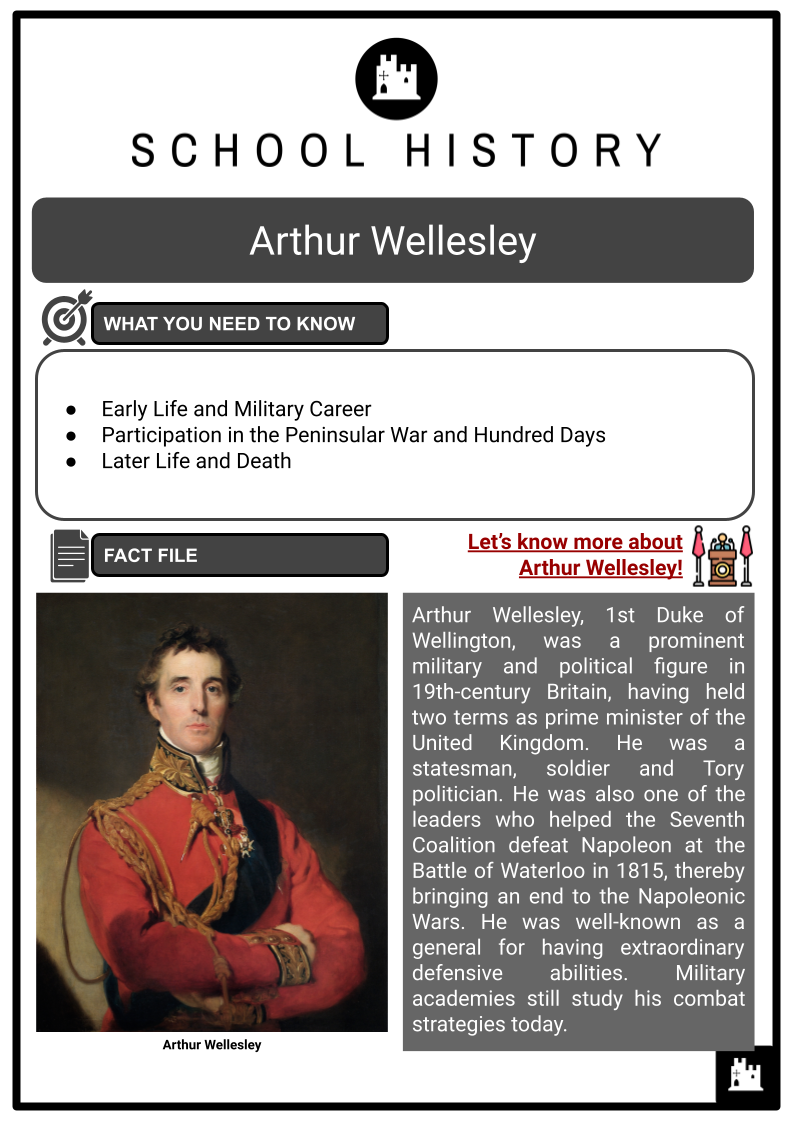
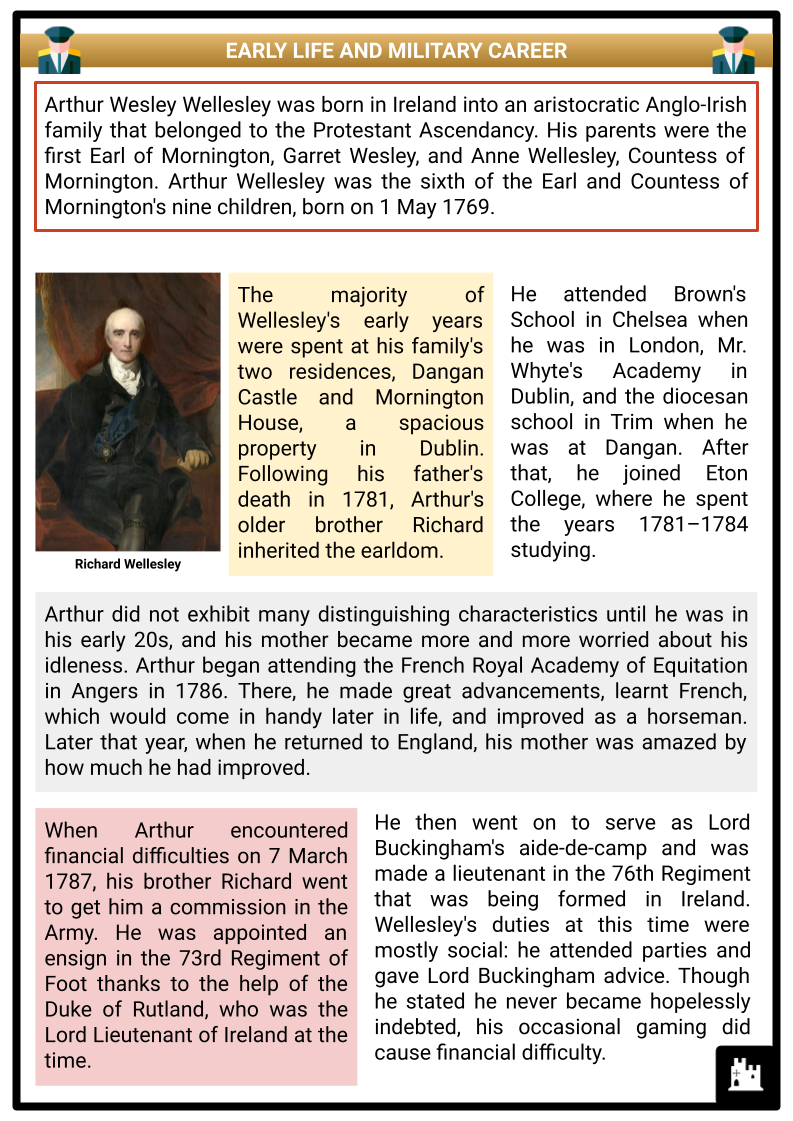
Student Activities
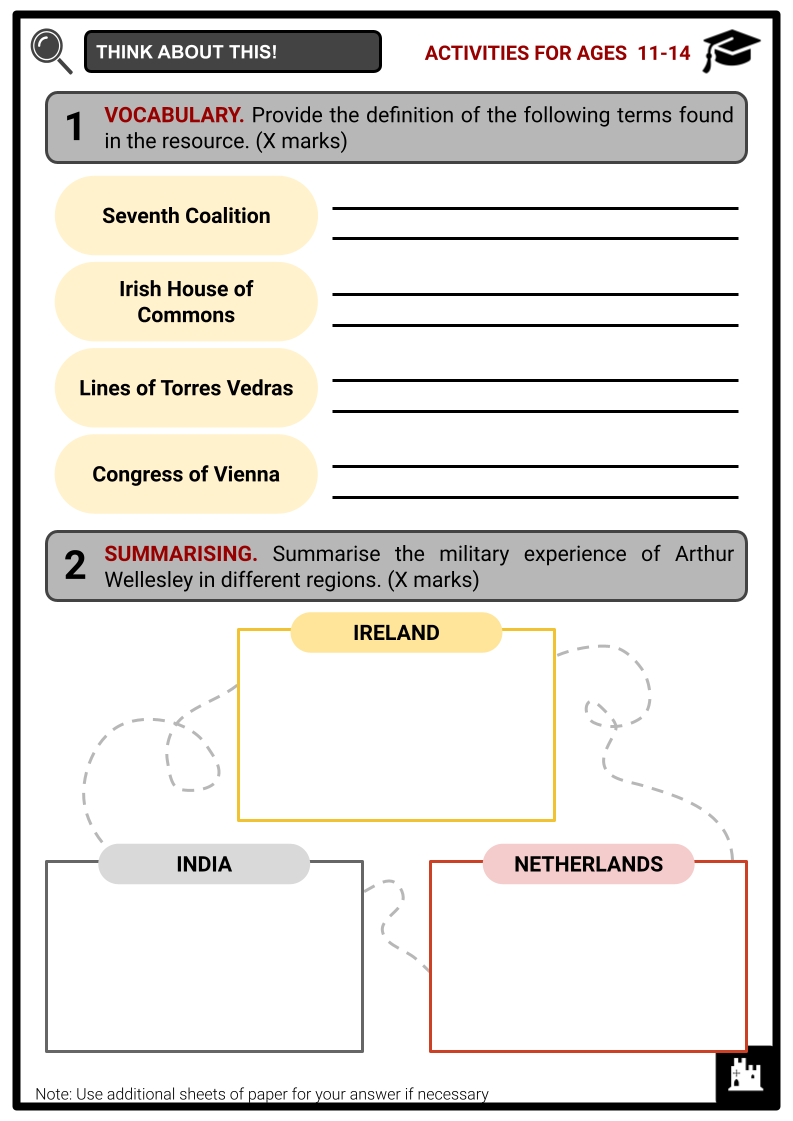
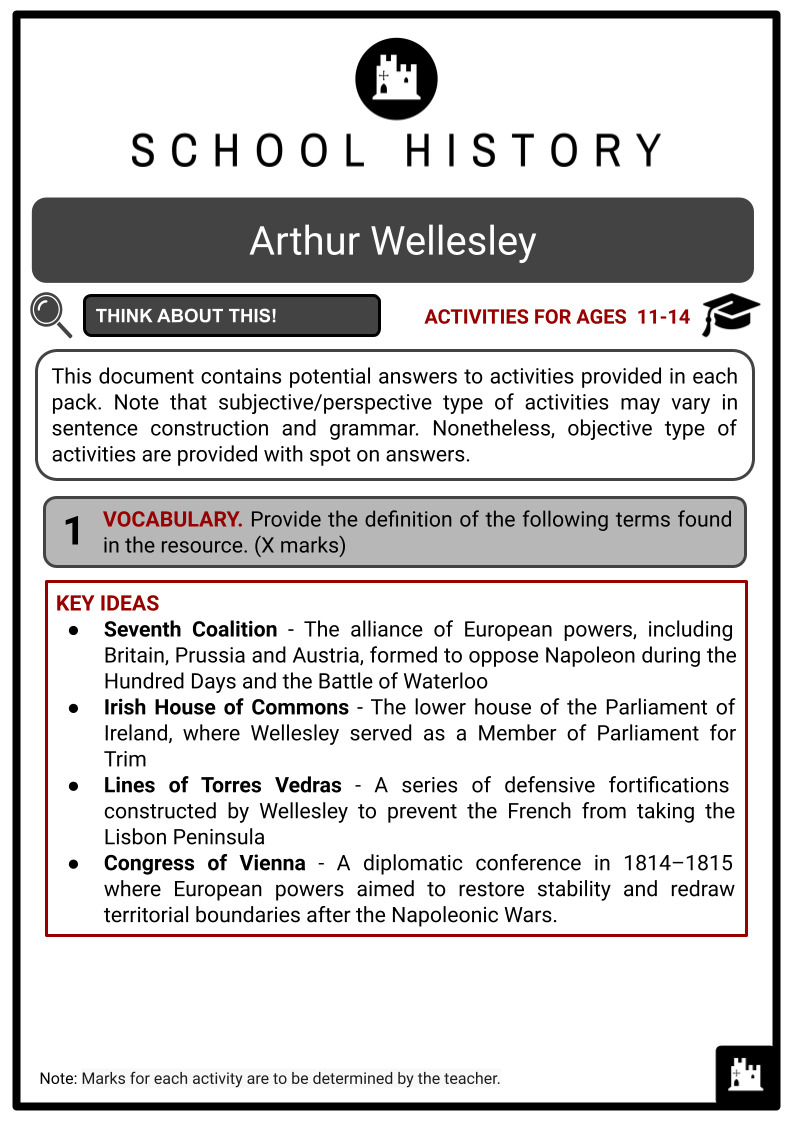
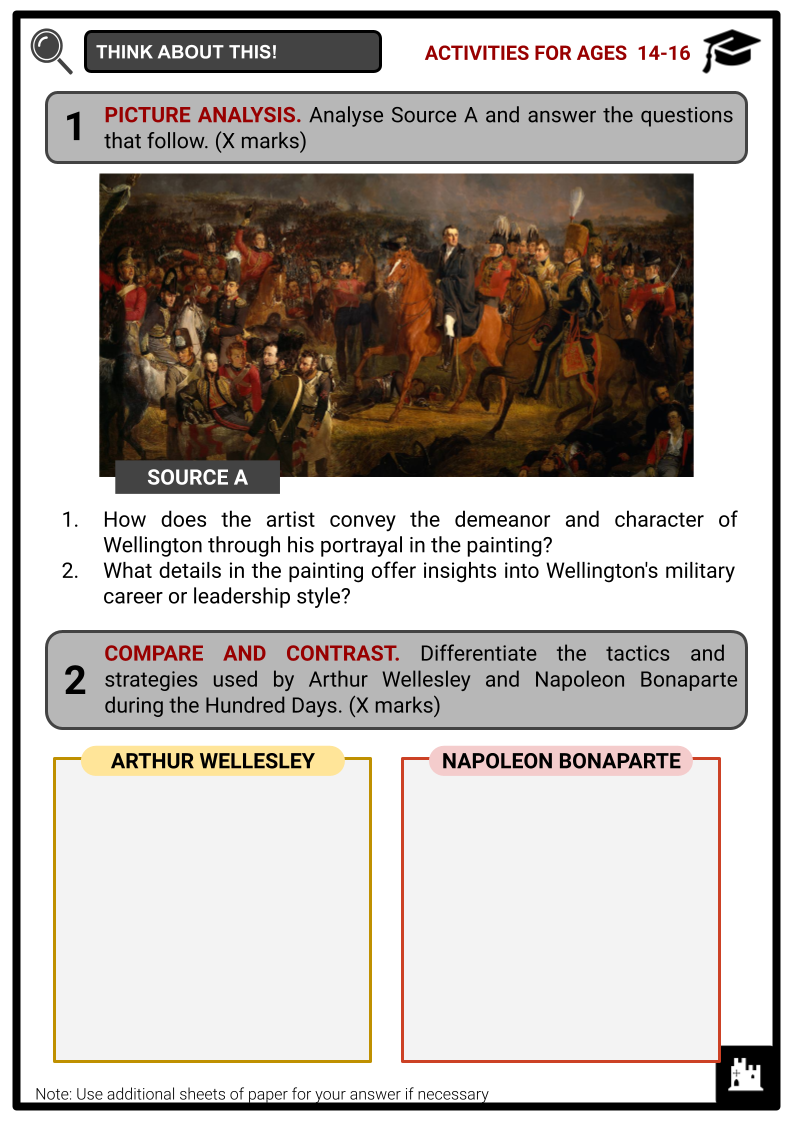
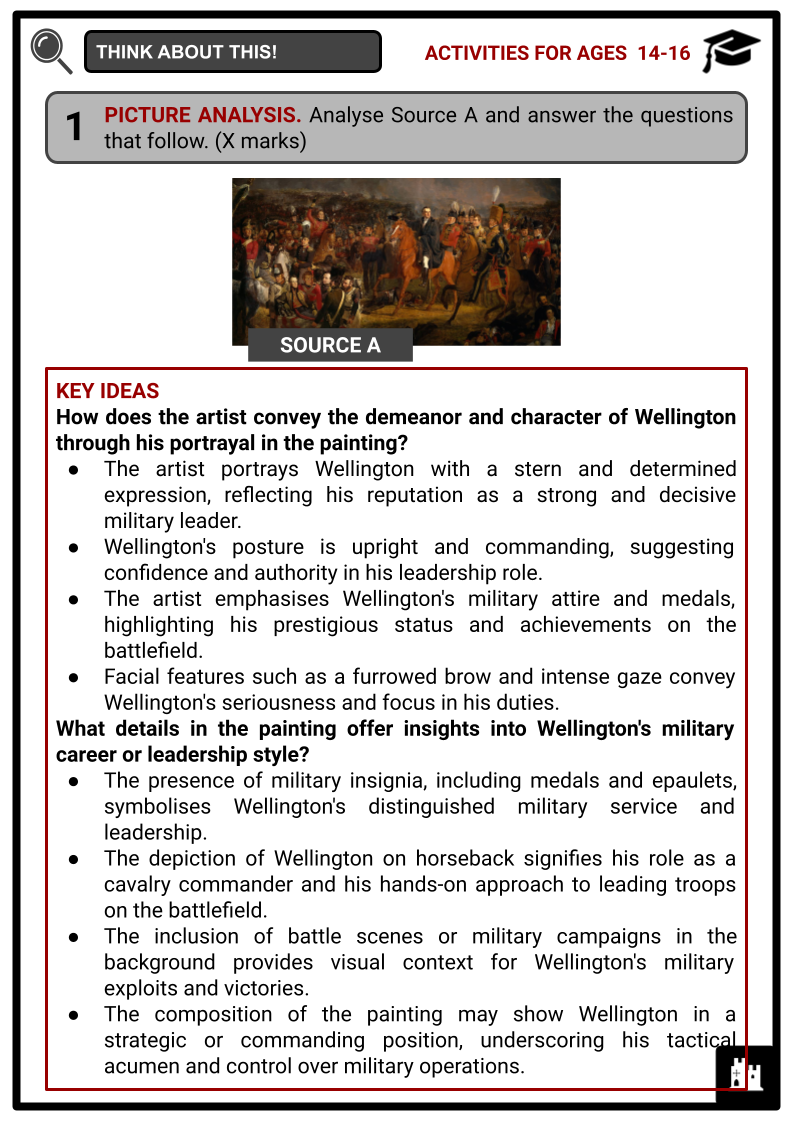
Summary
- Early Life and Military Career
- Participation in the Peninsular War and Hundred Days
- Later Life and Death
Key Facts And Information
Let’s know more about Arthur Wellesley!
Arthur Wellesley, 1st Duke of Wellington, was a prominent military and political figure in 19th-century Britain, having held two terms as prime minister of the United Kingdom. He was a statesman, soldier and Tory politician. He was also one of the leaders who helped the Seventh Coalition defeat Napoleon at the Battle of Waterloo in 1815, thereby bringing an end to the Napoleonic Wars. He was well-known as a general for having extraordinary defensive abilities. Military academies still study his combat strategies today.
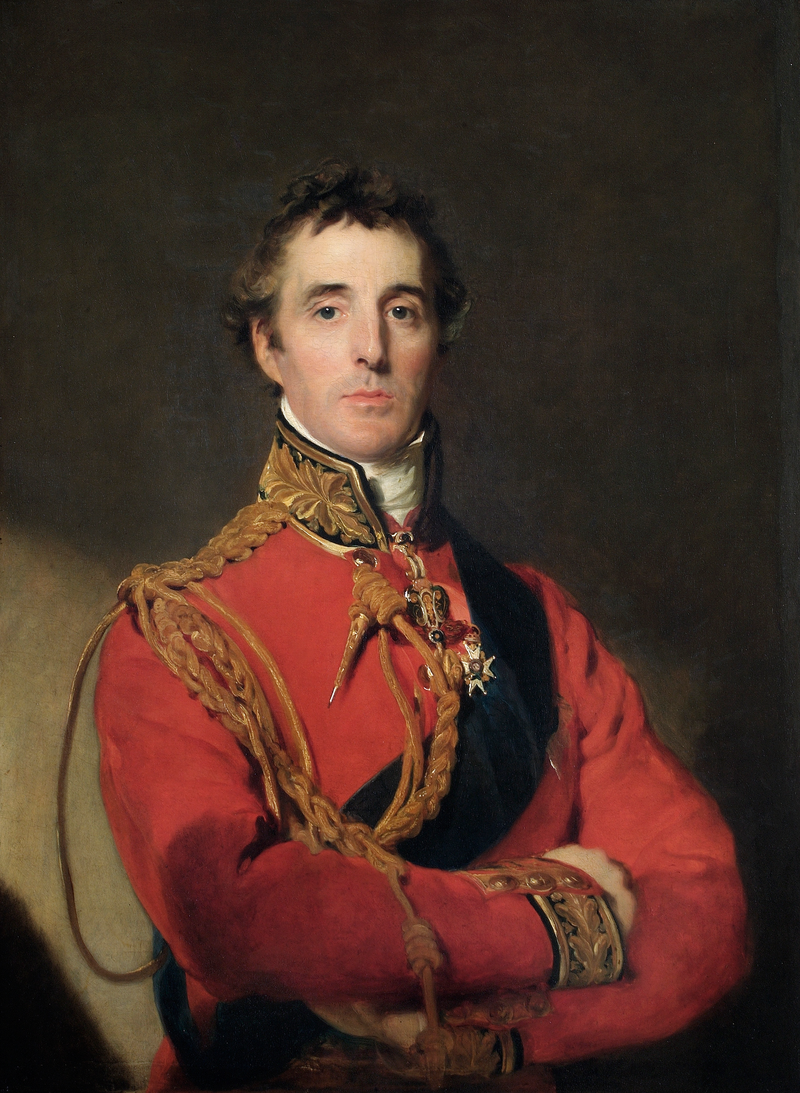
EARLY LIFE AND MILITARY CAREER
- Arthur Wesley Wellesley was born in Ireland into an aristocratic Anglo-Irish family that belonged to the Protestant Ascendancy. His parents were the first Earl of Mornington, Garret Wesley, and Anne Wellesley, Countess of Mornington. Arthur Wellesley was the sixth of the Earl and Countess of Mornington's nine children, born on 1 May 1769.
- The majority of Wellesley's early years were spent at his family's two residences, Dangan Castle and Mornington House, a spacious property in Dublin. Following his father's death in 1781, Arthur's older brother Richard inherited the earldom.
- He attended Brown's School in Chelsea when he was in London, Mr. Whyte's Academy in Dublin, and the diocesan school in Trim when he was at Dangan. After that, he joined Eton College, where he spent the years 1781–1784 studying.
- Arthur did not exhibit many distinguishing characteristics until he was in his early 20s, and his mother became more and more worried about his idleness. Arthur began attending the French Royal Academy of Equitation in Angers in 1786. There, he made great advancements, learnt French, which would come in handy later in life, and improved as a horseman. Later that year, when he returned to England, his mother was amazed by how much he had improved.
- When Arthur encountered financial difficulties on 7 March 1787, his brother Richard went to get him a commission in the Army. He was appointed an ensign in the 73rd Regiment of Foot thanks to the help of the Duke of Rutland, who was the Lord Lieutenant of Ireland at the time.
- He then went on to serve as Lord Buckingham's aide-de-camp and was made a lieutenant in the 76th Regiment that was being formed in Ireland. Wellesley's duties at this time were mostly social: he attended parties and gave Lord Buckingham advice. Though he stated he never became hopelessly indebted, his occasional gaming did cause financial difficulty.
- In the late 1780s and early 1790s, Wellesley changed regiments many times.
- On 23 January 1788, he transferred to the 41st Regiment of Foot, and on 25 June 1789, he joined the 12th (Prince of Wales's) Regiment of (Light) Dragoons.
- Concurrently, he ventured into politics and ran in Trim for the 1789 general election against Henry Grattan of the Irish Patriot Party.
- After being elected to the Irish House of Commons, Wellesley sided with the administration as a Member of Parliament for Trim.
- He proceeded with his military career, rising to the rank of captain before joining the 58th Foot Regiment.
- Wellesley fell in love with Kitty Pakenham after enlisting in the 18th Light Dragoons on 31 October 1791. He redoubled his efforts to pursue a career in the military even after his proposal to her was turned down. By 1793, he was a major in the 33rd Regiment and had bought a lieutenant colonelcy in the same regiment with his brother's financial help. This was a watershed moment for him as he turned his attention to a focused pursuit of military prowess.
- Arthur eventually married Kitty Pakenham in Dublin on 10 April 1806, officiated by his brother Gerald, a clergyman. The couple had two children, Arthur (born 1807) and Charles (born 1808), but their marriage was strained by his prolonged absences due to campaigns, leading to emotional distance. Living separately, Kitty spent most of her time at their country home, Stratfield Saye House, while Wellesley resided in their London home, Apsley House.
- Arthur Wellesley enlisted in the 33rd Regiment and joined the Duke of York's British contingent in 1793, during the French Revolutionary Wars, which were headed towards an invasion of France. They arrived too late to take part in the intended invasion, but on 15 September 1794, they did engage in the Battle of Boxtel, where Wellesley, temporarily leading his brigade, had his first combat. Even though the war was a disaster, he gained important experience in battle tactics, realising the value of infantry lines and the necessity of robust naval assistance.
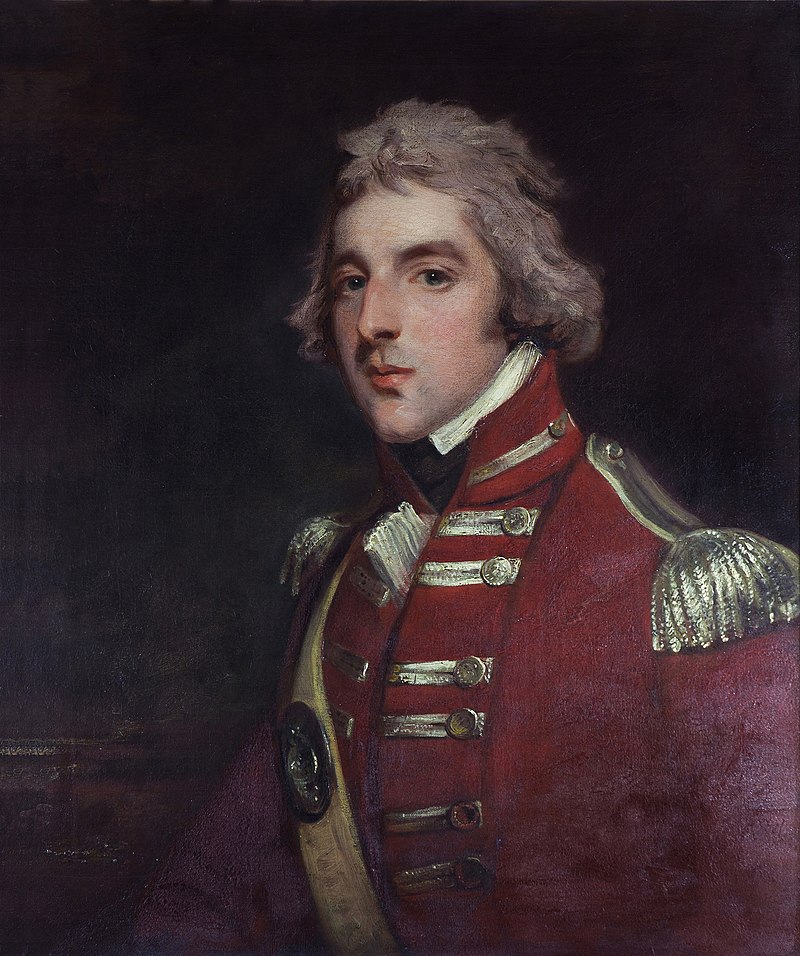
- When Arthur Wellesley returned to England in March 1795, he went back to his political duties and turned down the position of Surveyor-General of the Ordnance in favour of joining his army. Whitehall diverted the 33rd to India when storms hampered their journey to the West Indies, and on 3 May 1796, Wellesley, who had been elevated to the rank of full colonel, sailed for Calcutta.
- Arthur Wellesley arrived in Calcutta in February 1797 and stayed there for five months before leaving for a quick trip to the Philippines in August. During the voyage, he adjusted his soldiers to the new climate by introducing additional sanitary procedures. When he returned to India in November, he discovered that Richard, his older brother, had taken over as the country's new governor-general.
- The Fourth Anglo-Mysore War erupted in 1798, with the British East India Company aiming to extend its rule.
- Arthur's brother, now Lord Mornington, ordered an armed force to capture Seringapatam and defeat Tipu Sultan.
- Wellesley played a crucial role in the war, facing challenges such as the Battle of Sultanpet Tope, where he launched a successful attack after an initial setback.
- The use of rockets during the conflict left a lasting impression on Wellesley, who recognised the need for careful logistical preparation.
- In 1800, as Governor of Mysore, Wellesley faced an insurgency led by Dhoondiah Waugh. After overcoming several setbacks, including the destruction of Dhoondiah's forces and forts, Wellesley's successful campaign restored British authority and earned him the promotion to brigadier-general in July 1801.
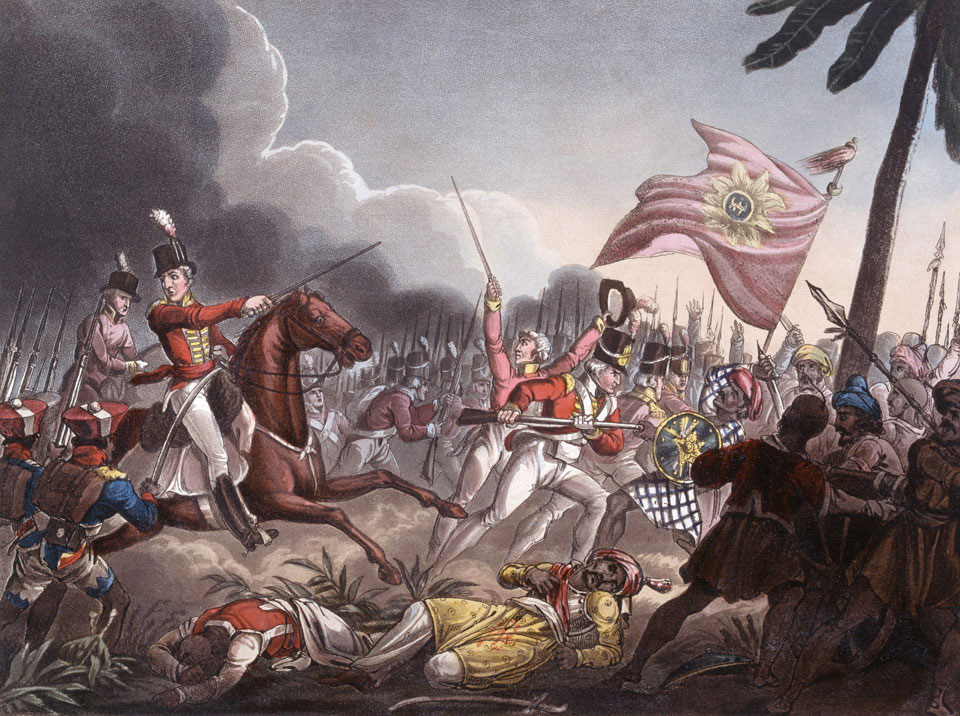
- Wellesley's military prowess continued in 1801, with plans to capture Batavia and Mauritius redirected to an expedition to Egypt. Promoted to major-general in September 1802, Wellesley later commanded an army in the Second Anglo-Maratha War, showcasing his strategic acumen at the Battle of Assaye in September 1803 and achieving victory in subsequent engagements.
- Tired of his time in India, Wellesley sought permission to return to England in June 1804. Upon his departure in March 1805, he was made a Knight of the Bath. The wealth he amassed in India, primarily from campaign prize money, amounted to £42,000, contributing to his financial success.
PARTICIPATION IN THE PENINSULAR WAR AND HUNDRED DAYS
- In September 1805, Major-General Wellesley, newly returned from his successful campaigns in India, sought a new assignment and encountered Vice-Admiral Horatio Nelson in the waiting room of the Secretary of State for War and the Colonies. Initially unimpressed by Nelson's vain and silly demeanour, Wellesley's perception changed during a subsequent conversation where Nelson, upon learning Wellesley's identity, adopted a more serious and equal tone.
- The two men engaged in a discussion on the war, the state of the colonies, and geopolitical matters. Despite this being their only meeting, the exchange left a lasting impression on Wellesley, who found the conversation highly interesting. Nelson's victory at Trafalgar occurred seven weeks later, marking the end of their interaction.
- After serving in the unsuccessful Anglo-Russian expedition to north Germany in 1805, Wellesley took an extended leave from the army. In January 1806, he was elected as a Tory Member of Parliament for Rye and later for Newport on the Isle of Wight a year later. Concurrently, Wellesley assumed the role of Chief Secretary for Ireland under the Duke of Richmond and became a privy councillor.
- During this time in Ireland, he made verbal assurances regarding the enforcement of Penal Laws with moderation, possibly foreshadowing his later support for Catholic emancipation.
- In May 1807, while in Ireland, Wellesley learnt of the British expedition to Denmark-Norway and decided to participate.
- He was appointed to command an infantry brigade in the Second Battle of Copenhagen, where his men took 1,500 prisoners.
- Wellesley returned to England by 30 September 1807, and was subsequently promoted to the rank of lieutenant general on 25 April 1808.
- In June 1808, he accepted command of an expedition destined for South America but was instead ordered to sail for Portugal to join the Peninsular Campaign.
- On 12 July 1808, Arthur Wellesley left Cork to join the war against French forces in the Iberian Peninsula. He demonstrated his command skills by defeating the French at the Battle of Roliça and the Battle of Vimeiro in 1808. However, he was subsequently superseded in command, and General Dalrymple signed the controversial Convention of Sintra, allowing the French army to be transported out of Lisbon with their loot. Wellesley, along with Dalrymple, faced a Court of Enquiry upon their return to Britain. Although Wellesley had agreed to the preliminary armistice, he had not signed the convention and was cleared of any wrongdoing.
- In January 1809, amid Napoleon's efforts to quell a Spanish revolt, British Commander Sir John Moore died during the Battle of Corunna. Despite challenges in the broader war against France, the Peninsula became a theatre of effective resistance for the British and Portuguese. As the leader of all British forces in Portugal, Wellesley strategically retreated into Portugal following the Battle of Talavera in 1809, earning him the title of Viscount Wellington of Talavera.
- In 1810, Wellesley implemented strategic measures, including slowing Marshal Masséna at Buçaco and constructing the Lines of Torres Vedras, preventing the French from taking the Lisbon Peninsula.
- In 1811, he checked Masséna at the Battle of Fuentes de Oñoro, and his promotion to full general in July 1811 recognised his services.
- In 1812, Arthur Wellesley achieved military successes, capturing Ciudad Rodrigo, storming Badajoz, and winning decisively at the Battle of Salamanca, earning him the titles of Earl and later Marquess of Wellington. Despite a failed attempt to capture Burgos, he strategically withdrew from advancing French forces under Soult and Marmont.
- In 1813, Wellesley launched a successful offensive, outflanking the French through the Tras os Montes hills and prompting their retreat from Madrid and Burgos.
- The Battle of Vitoria showcased his leadership, although British troops breaking ranks to loot prompted his famous comment about having 'the scum of the earth'.
- Following Vitoria, he faced challenges at San Sebastián, forced Soult's retreat through battles at the Pyrenees, Bidassoa and Nivelle, invaded southern France with victories at the Nive and Orthez, and achieved a final encounter with Soult at Toulouse, agreeing to a ceasefire due to news of Napoleon's defeat and abdication.
- In recognition of his military triumphs, Arthur Wellesley was hailed as a conquering hero and made Duke of Wellington on 3 May 1814. His popularity in Britain was not only due to his military successes but also to his image and appearance, influencing fashion trends of the time. His tall, lean figure, plumed black hat, and classic uniform became widely popular. He served as Ambassador to France and later took Lord Castlereagh's place as the first plenipotentiary to the Congress of Vienna. On 2 January 1815, his Knighthood of the Bath was elevated to Knight Grand Cross with the expansion of the order.
- On 26 February 1815, Napoleon escaped from Elba and returned to France, swiftly regaining control of the country by May and facing renewed opposition from the Allies. In what became known as the Waterloo Campaign, Wellington left Vienna and assumed command of the British-German army alongside Dutch and Prussian forces led by Generalfeldmarschall Gebhard Leberecht von Blücher.
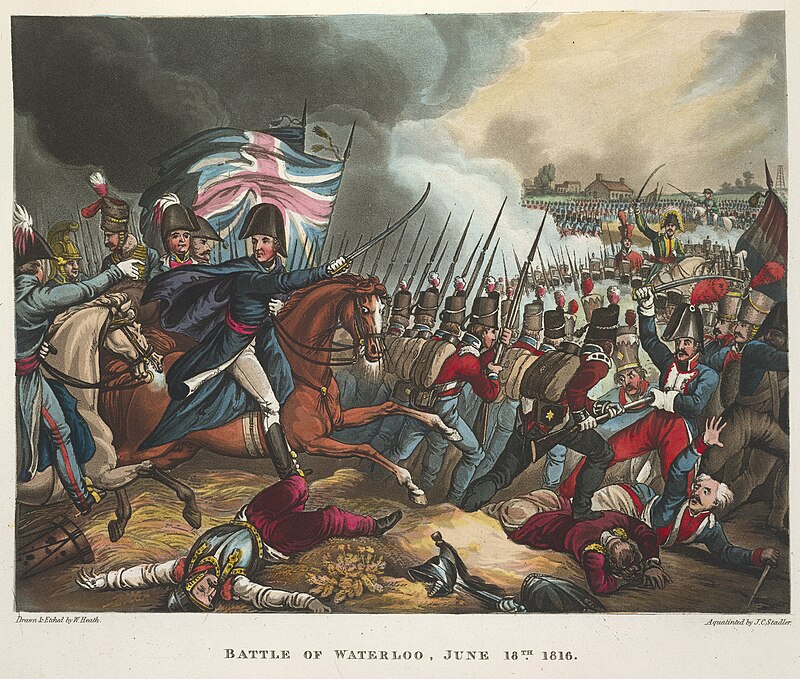
- Napoleon aimed to isolate and defeat the Allied and Prussian armies separately before the Austrians and Russians could arrive, diminishing the Coalition's numerical superiority. The French invaded the Netherlands, and after Napoleon's victory over the Prussians at Ligny and Marshal Ney's indecisive engagement with Wellington at Quatre Bras, the Prussians retreated to Wavre, while Wellington withdrew to a strategically chosen position south of Waterloo.
- The Battle of Waterloo took place on 18 June 1815, with torrential rain hampering movements. The Duke of Wellington, leading an Anglo-Dutch-German army of approximately 73,000 troops, including 26,000 British, faced Napoleon for the first time in a decisive confrontation. About 30% of Wellington's British forces were Irish.
- The battle began with a diversionary attack by French soldiers on Hougoumont, followed by a cannon barrage and the launch of the first French infantry attack led by Comte D'Erlon's I Corps. The French initially succeeded in pushing Allied troops back through the main position, storming La Haye Sainte but failing to capture it. Lord Uxbridge's cavalry then engaged, capturing two French Imperial Eagles but suffering heavy losses in return.
- At around 4pm, Marshal Ney, mistaking casualties for a retreat, launched an ill-fated cavalry charge against Wellington's centre.
- At the same time, the first Prussian corps, commanded by Freiherr von Bülow, arrived, impacting the battle. The French cavalry attacks persisted, and Ney eventually organised a combined-arms assault with infantry and cavalry.
- La Haye Sainte was captured by the French, and Ney attacked Wellington's infantry squares at short range with a canister, causing significant losses.
- Wellington's centre was on the brink of collapse when Prussian reinforcements, including Zieten's corps and Pirch I's corps, arrived, helping regain possession of Plancenoit.
- As the French fiercely attacked the Coalition along the line, Napoleon deployed the Imperial Guard at 7.30pm. The Guard's attack involved five battalions of the Middle Guard, advancing through canister and skirmisher fire.
- Despite facing severe outnumbering, they separated into three attack forces. One prong defeated the Coalition's first line, but a fresh Dutch division and the Allied artillery halted their advance.
- The Foot Guards under Maitland dealt a devastating blow to the second prong, and the third prong, a fresh Chasseur battalion, was also defeated by British forces. Panic spread among the French as the Guard retreated headlong, and Wellington signalled an Allied advance just as the Prussians overran the French positions to the east. The French army abandoned the field, and the Treaty of Paris was signed on 20 November 1815.
LATER LIFE AND DEATH
- Arthur Wellesley reentered politics with several key appointments in the Tory government, including Master-General of the Ordnance on 26 December 1818, Governor of Plymouth on 9 October 1819, Commander-in-Chief of the British Army on 22 January 1827, and Constable of the Tower of London on 5 February 1827. Alongside Robert Peel, he gained influence within the Tory party, leading to his resignation as Commander-in-Chief in 1828 to become prime minister.
- Wellington's term as prime minister was notable for Roman Catholic Emancipation, and the restoration of civil rights to Roman Catholics in the United Kingdom.
- Daniel O'Connell's by-election win and subsequent election despite legal restrictions prompted this change.
- Facing strong opposition, Wellington spoke for Catholic Emancipation in the House of Lords, and despite opposition from many Tories, the Roman Catholic Relief Act of 1829 was passed.
- Wellington had threatened to resign if King George IV did not give Royal Assent.
- The Earl of Winchilsea accused Wellington of an 'insidious design' for the introduction of Popery, leading to a duel in March 1829.
- Despite both firing harmlessly, honour was saved, and Winchilsea apologised.
- The nickname 'Iron Duke' originated during this period, reflecting Wellington's resolute political will amid personal and political unpopularity, exemplified by a hostile reception at the opening of the Liverpool and Manchester Railway.
- Wellington died on 14 September 1852, at Walmer Castle in Kent, aged 83, succumbing to the after-effects of a stroke and a series of seizures. He was one of the few British subjects to have his body brought to London by train for a state burial, even though he had never travelled by rail during his lifetime.
- On 18 November 1852, his body was laid to rest in state at the Royal Hospital Chelsea. Both the public and members of the royal family attended the burial, which led to deadly crashes because of the large number of attendees. Alfred Stevens' bronze monument, which has elaborate depictions of 'Truth tearing the tongue out of the mouth of Falsehood' and 'Valour trampling Cowardice underfoot',' marks the location of his ultimate resting place in St. Paul's Cathedral.
- During Wellington's funeral procession, his casket was adorned with banners, including one from Prussia, later removed during World War I and never reinstated. The 'Great Banner' was carried in the procession by General Sir James Charles Chatterton of the 4th Dragoon Guards on the orders of Queen Victoria, reflecting the high regard in which Wellington was held.
Image Sources
- https://en.wikipedia.org/wiki/Arthur_Wellesley,_1st_Duke_of_Wellington#/media/File:Sir_Arthur_Wellesley,_1st_Duke_of_Wellington.png
- https://en.wikipedia.org/wiki/Arthur_Wellesley,_1st_Duke_of_Wellington#/media/File:Arthur_Wellesley_by_John_Hoppner.jpg
- https://en.wikipedia.org/wiki/Arthur_Wellesley,_1st_Duke_of_Wellington#/media/File:Battle_of_Assaye.jpeg
- https://en.wikipedia.org/wiki/Arthur_Wellesley,_1st_Duke_of_Wellington#/media/File:The_Battle_of_Waterloo,_June_18th_1815_-_The_wars_of_Wellington,_a_narrative_poem_(1819),_before_169_-_BL.jpg
Frequently Asked Questions
- Who was Arthur Wellesley, 1st Duke of Wellington?
Arthur Wellesley, 1st Duke of Wellington, was a British military leader and statesman best known for his pivotal role in defeating Napoleon Bonaparte and Britain's two-term prime minister.
- What were Arthur Wellesley's military achievements?
Wellesley's military career was distinguished by his leadership in several successful campaigns, most notably during the Peninsular War in Spain and Portugal.
- How did Arthur Wellesley become the Duke of Wellington?
Wellesley was granted the title of Duke of Wellington in recognition of his military achievements, notably his victory at the Battle of Vitoria in 1813 during the Peninsular War.
